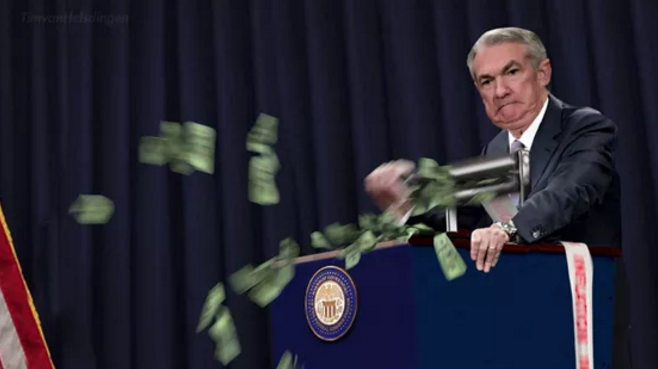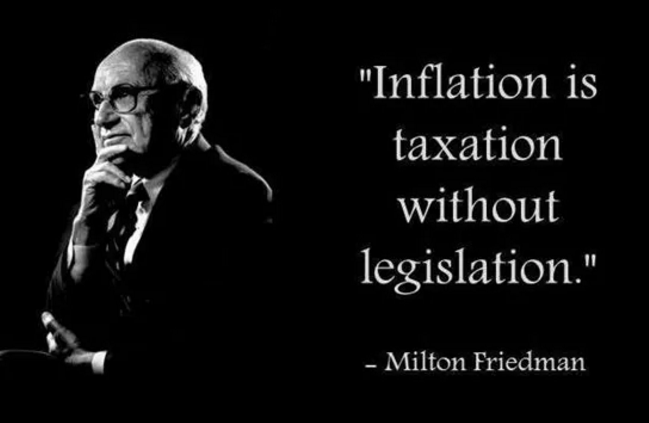As we all know, as early as more than a decade ago during the global financial crisis, the Federal Reserve began to operate their money printing presses at full power, and the operation of the printing presses became even more crazy under the outbreak of the novel coronavirus epidemic.
As of May 13, the Fed's balance sheet had reached $6.98 trillion, according to data. In the first week of March, the Fed's balance sheet was $4.29 trillion. This kind of "printing money" is faster than ever before, including during the 2008 international financial crisis.
But where did the money they printed go?
Why didn't the United States experience hyperinflation like Weimar, Germany, Venezuela and Zimbabwe?

Ted Bauman, a financial writer and investor, wrote that it is both simple and complex to explain the problem. This is because most of the certainty in people's minds about economic issues is based on ideology rather than an observable analysis of the real world.
Ideological resistance to monetary inflation arose in the 1960s. At the time, Milton Friedman of the University of Chicago, an American economist, suggested that the Fed should control the money supply to limit inflation. In Friedman's view, inflation is always caused by an oversupply of money.

However, the history of the past decade has proved that his judgment is actually wrong. As a matter of fact, over the past few decades, people's fear of inflation has mainly come from the cultivation of the financial industry, and they certainly have their own dark plans behind this.
For example, if your company lends money to others to earn interest, you certainly want inflation to be as low as possible. If inflation is high, the money paid back by the other party will shrink its purchasing power. Therefore, there are very good reasons for the financial industry to suppress inflation.
However, in recent years, the situation has changed dramatically, and the financial industry has fallen in love with the money printing press. This is because the inflation caused by printing money is not just in the field of real economic activity.
More money, less inflation.

Torsten Slok, Deutsche Bank's chief international economist, actually touched on this topic indirectly not long ago, writing in a research note to clients last week: "you can expand the Fed's balance sheet and increase the money supply as you wish. As long as these currencies flow into asset transactions, not real economic transactions, they will not cause inflation. "
It can be said that it is to the point, I am afraid that many people have not yet grasped his message.
You know, there are several kinds of inflation, and consumer inflation is actually just one of them. When the total amount of money in the economy greatly exceeds the system's ability to make goods, there will be consumer price inflation. People have more and more money, which will naturally lead to a rise in commodity prices. In this situation, there are only two ways to curb inflation, either by reducing monetary output or by increasing economic capacity.

Over the past decade or so, the US economy has essentially been in a state of overcapacity, and the unemployed or underemployed population is one of its intuitive manifestations. As for now, of course, not to mention the full release of capacity. GDP shrank by 5% in the first quarter of this year and is expected to shrink by as much as 20% in the second quarter.
So the question is, is there too much money in such an economic system?
In the study, Sloke pointed out that the use of money and the speed of circulation in the US economic system, the so-called turnover rate, is declining dramatically.

As can be seen from the chart above, US currency turnover began to decline rapidly after peaking in the second half of the 1990s, and this momentum became more pronounced after the 2008 financial crisis.
It is true that the pace of economic recovery over the past decade has been slow, but the economy has always been growing, and there is no reason for the frequency of money supply to collapse so sharply.
As a result, there is probably only one plausible explanation for the decline in currency turnover-there has indeed been a substantial increase in money in the US economy, except that the increase in money does not appear in the area where people buy real goods and services.

As a result, the increase in the money supply has not led to consumer price inflation.
The stock market has long been hyperinflationary.
So where is the money printed by the Fed?
In the money supply series, M2 refers to the money that consumers use in the real economy, such as notes and coins in circulation, bank accounts and money in money market fund accounts.

M3 refers to the expansion of the Fed's balance sheet, banks' reserves with the Fed, institutional money market funds, and liquid investment instruments such as government bonds. Currently, the M3 is about four times the size of M2-$15.5 trillion versus $4.2 trillion.
The Fed has printed large amounts of liquidity to buy government bonds from commercial banks to replenish their reserves. In this case, the increase in the money supply actually occurs at the M3 level.
Banks can then use these reserves to lend to households and businesses to stimulate economic activity. When these loans are released, the money supply at the M2 level increases.

However, no one requires the bank to lend money. They can choose to invest these reserves in a variety of paper assets-such as stocks.
That's the point. Since the financial crisis, most of the new money "created" by the Fed has flowed into M3, eventually chasing paper assets, and not much into M2, which is really closely related to the real economy.
That is why there has never been hyperinflation in the US economy, which many people think is inevitable. When everyone is looking for inflation, they are looking in the wrong place. Hyperinflation is actually just around the corner. In the stock market! Look at how the price-to-earnings ratio has skyrocketed over the past decade.

The virtual reality game will come to an end.
With the combination of the Fed's frenzied printing of money and the faltering pace of real economic growth, the US stock market has staged the most significant inflation in the US over the past decade-asset price inflation.
As soon as they get the money that the Fed has just printed, banks will always put it on the asset market. In business, there is also a good reason to do so-asset price inflation can bring huge gains, while investment in a sluggish real economy, returns are pitifully low.
However, people should not forget that inflation is only a change in numbers after all, and it does not mean that the real economic value of these assets has been increased.

As a result, the 2020 market looks more and more like a virtual reality video game. The game is full of amazing experiences, and you can score very high. But none of this is real reality, on the contrary, it is just a bunch of numbers that are out of touch with reality and have no real meaning. The underlying driving force behind these numbers is hyperinflation in asset prices created by the Fed, rather than a healthy real economy.
Of course, in the process, you may also make real money by investing in U. S. stocks. However, in the final analysis, sooner or later, the Fed's hyperinflationary policy will push the stock market to the point where it is extremely far away from reality and absurd, and then there will only be another collapse.
On that day, can you guess whether the purchasing power of your real money will collapse with it?
Edit / Edward
